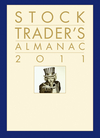
Stock Trader's Almanac 2011
For customer care, special sales, or to find your rep, please visit our Contact Us page.
2011 Outlook
President Obama’s first two years have been quite rocky, it has been an uphill battle for the new president, but the stock market has rallied swiftly and powerfully. The president pushed through many of his core agenda and policy items after some tough political battles.
As with most of his predecessors, Obama will push hard to pass several other policy initiatives in 2010. These divisive initiatives have already helped create a typical midterm election year correction. If the Democrats lose control of Congress, it could be a boon for stocks. The combination of a democratic president and a republication Congress has produced the greatest gains, averaging gains of 19.5% for the Dow since 1949.
The Obama political machine is well aware that they will need to begin priming the pump in 2011 if he is going to have a shot at a second term. If Democrats work more effectively with Republicans and can grease the wheels of the economy, the prospects for a 50% gain from the midterm low to the pre-election year high—and Obama’s reelection in 2012—increase dramatically.
However, expect several more years of sideways market action, as we experienced in the 1930s and 1940s, and the 1970s and 1980s, before the Next Super Boom is born and the Dow vaults 500% to 38,820 by 2025. Use any significant dips or bear market lows to position for a big rally into 2011 and 2012, but do not get complacent as the secular bear still appears in command.
50% Moves – Midterm Elections and the Stock Market
Politics are now dominating the discussion on Main Street and Wall Street in midterm election year 2010. President Obama will be hard pressed to avoid what has been the inevitable trend of presidential party House seat-loss in the midterm elections. Even midterm election years (like 2010 so far) that do not suffer significant declines see massive moves from the midterm low to the pre-election year high. The Dow has gained 45% on average since 1901. Even the tepid declines in 1985, 1994 and 2006 were followed by major moves ranging from 33% to 81%.
Pre-Presidential Election Years
No Losers in 72 Years
There hasn’t been a down year in the third year of a presidential term since war-torn 1939, Dow off 2.9%. The only severe loss in a pre-presidential election year going back 100 years occurred in 1931 during the Depression. Most bear markets take place in the first or second years after elections. Then, the market improves. Typically each administration does everything in its power to juice up the economy so that voters are in a positive mood at election time. Prospects for 2011 look bright for at least the first half, following the mild breather thus far in 2010.






